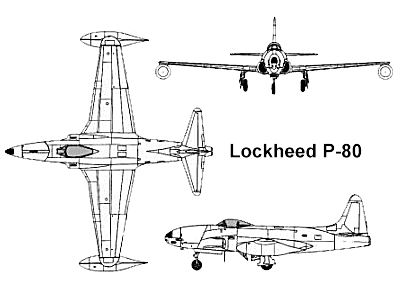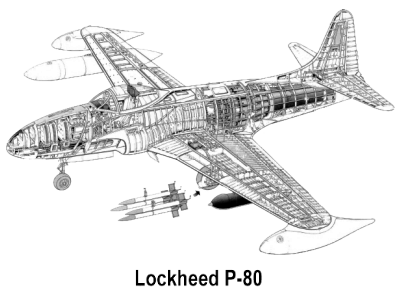The Lockheed P-80 'Shooting Star' was the first jet fighter used operationally by the United States Army Air Forces (USAAF). Designed and built by Lockheed in 1943 and delivered just 143 days from the start of the design process, production models were flying but not ready for service by the end of World War II. It was dubbed the 'Shooting Star' in honor of its unparalleled speed, its bullet-shaped fuselage, flush rivets, and smooth skin, Designed with straight wings, the type saw extensive combat in Korea with the United States Air Force as the F-80. America's first successful turbojet-powered combat aircraft, it helped usher in the "jet age" in the USAF, but was outclassed with the appearance of the swept-wing transonic MiG-15 and quickly replaced in the air superiority role by the transonic North American F-86 'Sabre'.
Back to Top
Development
The impetus for development of the P-80 was the discovery by Allied intelligence of the Me 262 in spring 1943, which had made only test flights of production prototypes at that time. After receiving documents and blueprints comprising years of British jet aircraft research, the commanding General of the Army Air Forces, Henry H. Arnold, believed an airframe could be developed to accept the British-made jet engine, and the Materiel Command's Wright Field research and development division tasked Lockheed to design the aircraft. With the Germans and British clearly far ahead in development, Lockheed was pressed to develop a comparable jet in as short a time as possible. Kelly Johnson submitted a design proposal in mid-June and promised that the prototype would be ready for testing in 180 days. The Skunk Works team, beginning 26 June 1943, produced the airframe in 143 days, delivering it to Muroc Army Airfield on 16 November. The XP-80 had a conventional all-metal airframe, with a slim low wing and tricycle landing gear. It was the first operational jet fighter to have its engine in the fuselage, a format previously used in the pioneering Heinkel He 178 of 1939, and the slightly later Gloster E.28/39 demonstrator of 1941. The first prototype (44-83020) was nicknamed Lulu-Belle (also known as 'the Green Hornet' because of its paint scheme). Powered by the replacement Halford H1 taken from the prototype de Havilland Vampire jet fighter, it first flew on 8 January 1944, with Lockheed test pilot Milo Burcham at the controls. The XP-80 eventually reached a top speed of 502 mph (808 km/h; 436 kn) at 20,480 ft (6,240 m), making it the first turbojet-powered USAAF aircraft to exceed 500 mph in level flight. The second prototype, designated XP-80A, was designed for the larger General Electric I-40 engine (an improved Rolls-Royce Derwent, later produced by Allison as the J33). Two aircraft (44-83021 and 44-83022) were built. 44-83021 was nicknamed the 'Gray Ghost' after its "pearl gray" paint scheme, while 83022, left unpainted for comparison of flight characteristics, became known as the 'Silver Ghost'. The P-80 testing program proved very dangerous. Lockheed test pilot Milo Burcham was killed on 20 October 1944 while flying the third YP-80A produced, 44-83025. The Gray Ghost was lost on a test flight on 20 March 1945, although pilot Tony LeVier escaped. The top-scoring WW II USAAF ace Major Richard Bong was also killed on an acceptance flight of a production P-80 in the United States on 6 August 1945.
Back to Top
In Service
Project 'Extraversion' Four YP-80's were sent to Europe for operational testing (demonstration, familiarization and possible interception roles) under Project Extraversion; two to England and two to the 1st Fighter Group at Lesina Airfield, Italy, but when test pilot Major Frederic Borsodi was killed in a crash caused by an engine fire on 28 January 1945, demonstrating YP-80A 44-83026 at RAF Burtonwood, the YP-80A was temporarily grounded. The remaining YP-80A in England went off to Rolls-Royce, on loan for flight tests with the Nene B.41 turbojet engine. YP-80A operations were strictly off-limits to regular USAAF personnel. Between January and March 1945 however, two American pre-production Lockheed YP-80A Shooting Star fighter jets did see limited service in Italy with the USAAF. While both test and operational pilots flew the YP-80As, civilians maintained them. The jet deployments to Europe were already classified and became even more so after the Borsodi crash in England. It's unclear whether anyone expected these YP-80As to see combat however one purpose of their journey was to build the morale of Eighth and Fifteenth Air Force heavy bomber crews, who were confronting German jets every day. Unfortunately, because of delays in delivery of production aircraft, the P-80 saw no actual combat during the conflict.
Back to Top
Korea
Some 75 percent of enemy losses during the initial months of the Korean campaign were due to air attacks by the F-80 ('P' prefix for Pursuit was replaced with 'F' for Fighter aircraft in 1947 upon creation the the USAF). The F-80 flew both air-to-air and air-to-ground sorties, claiming several aerial victories against North Korean Yak-9s and Il-10s. On 8 November 1950, an F-80 under the control of Lt. Russell Brown shot down a North Korean MiG-15 in the worlds first jet-versus-jet air battle. Ironically, due to the adverse conditions of the airfields in the Pusan perimeter along with supply and maintenance issues, the 35th Fighter-Interceptor Group and two squadrons, the 39th and 40th FIS, which went to Pohang, Korea in July 1950, had to give up their new F-80's and convert back to the F-51 'Mustang' before the end of the year. Later, as the war progressed north, they were again, re-equiped back with the F-80.
F-80 pilots claimed to have destroyed a total of six MiG-15s in aerial combat. When sufficient F-86 Sabres were in operation, the Shooting Star flew exclusively ground-attack missions, and were also used for advanced flight training duties and air defense in Japan. Of the 277 F-80s lost in operations (approximately 30% of the existing inventory), 113 were destroyed by ground fire and 14 shot down by enemy aircraft. F-80s are credited by the USAF with destroying 17 aircraft in air-to-air combat and 24 on the ground. By the end of hostilities, the only F-80s still flying in Korea were photo-reconnaissance variants.
These successes paved the way for subsequent iterations of the F-80, like the F-80B, which introduced the first ejection seat in a production U.S. aircraft, the F-94 all-weather interceptor and the speedy T-33 trainer, which remained in service until 1997. A total of 1715 P-80/F-80's along with other variants like the T-33 were built.
Back to Top



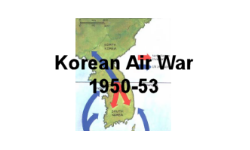 Korean War
Korean War P-80 Shooting Star
P-80 Shooting Star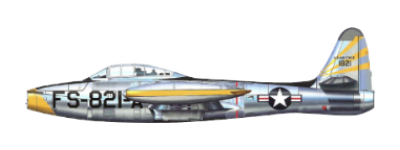 F-84 Thunderjet
F-84 Thunderjet F-86 Sabre
F-86 Sabre AD1 Skyraider
AD1 Skyraider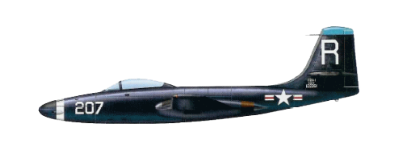 F2H Banshee
F2H Banshee F9F Panther
F9F Panther Seafury
Seafury Meteor
Meteor Mig-15
Mig-15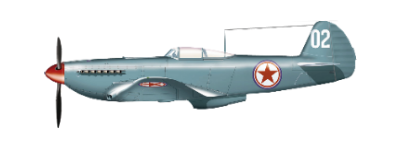 Yak-9
Yak-9 IL-10 Shturmovik
IL-10 Shturmovik



 Lockheed P-80/F-80 Shooting Star
Lockheed P-80/F-80 Shooting Star